Key Points on Why It Is a Capital Efficient Protocol
Written by: Castle Labs
Translated by: AididiaoJP, Foresight News
The money market is at the core of DeFi, where users can gain exposure to specific assets using various strategies. Over time, this vertical has grown in terms of total value locked (TVL) and functionality. With the introduction of new protocols like @MorphoLabs, @0xFluid, @eulerfinance, and @Dolomite_io, the range of functionalities achievable by lending protocols has gradually expanded.
In this report, we focus on one of these protocols: Fluid.
Fluid has launched several features, the most interesting of which are smart debt and smart collateral. It cannot be viewed as an ordinary lending protocol because it also combines its DEX functionality, providing users with more services.
Fluid shows significant growth trajectories in both the DEX and lending verticals, with a total market size (measured by total deposits) exceeding $2.8 billion.
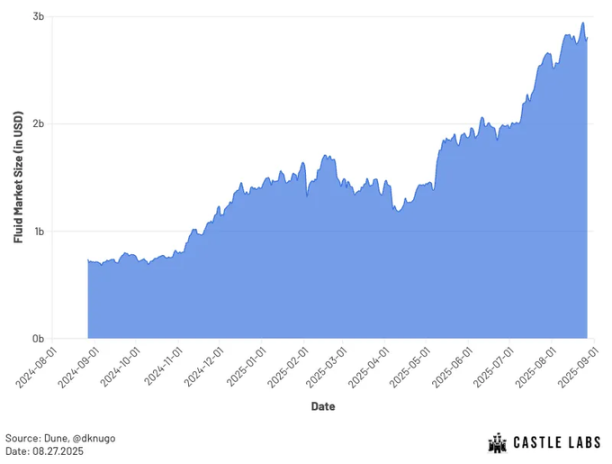
Fluid Market Size, Source: Dune, @dknugo
The market size of Fluid represents the total deposits within the protocol. The reason for choosing this metric over TVL is that debt is a productive asset within the protocol and contributes to exchange liquidity.
Overview of Fluid's Components and How It Works
This section briefly outlines the components of the Fluid protocol and explains how it operates, emphasizing why it is a capital efficient protocol.
Fluid adopts a unified liquidity model, allowing multiple protocols to share liquidity, including the Fluid lending protocol, Fluid Vaults, and DEX.
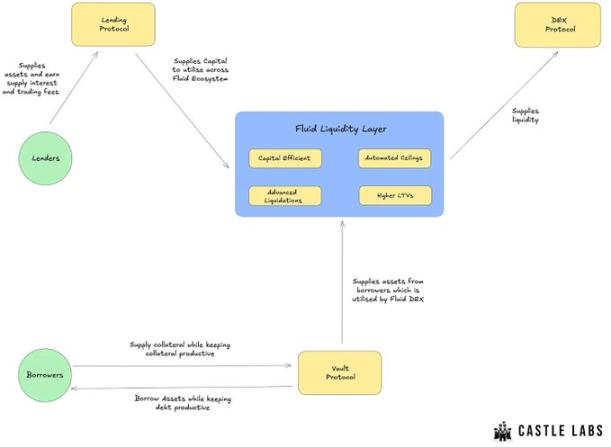
Fluid lending allows users to provide assets and earn interest. The assets provided here are utilized throughout the Fluid ecosystem, thereby enhancing their capital efficiency. It also opens up long-term yield opportunities, as the protocol continuously adapts to changes in market borrowers.
Fluid Vaults are single-asset, single-debt vaults. These vaults have extremely high capital efficiency because they allow for high LTV (loan-to-value) ratios, up to 95% of the collateral value. This figure determines the user's borrowing capacity, in contrast to the collateral deposited.
Additionally, Fluid employs a unique liquidation mechanism that reduces liquidation penalties to as low as 0.1%. The protocol only liquidates the necessary amount to restore the position to a healthy state. The liquidation process on Fluid is inspired by the design of Uniswap V3. It categorizes positions based on their LTV scale or range and executes batch liquidations when the collateral value reaches the liquidation price. The DEX aggregator then uses these batches as liquidity: liquidation penalties are converted into discounts for traders during exchanges.
Fluid DEX earns an additional layer of revenue from trading fees generated through swaps, further reducing the interest on borrowers' positions while enhancing the overall capital efficiency of the protocol. Different DEX aggregators, such as KyberSwap and Paraswap, utilize Fluid DEX as a source of liquidity to achieve deeper liquidity and increase trading volume.
On Fluid, users can deposit their collateral into the DEX and simultaneously earn lending fees and trading fees, making it a form of smart collateral.
If users wish to borrow against their collateral, they can either borrow assets or take on smart debt positions, making the debt productive. For example, users can borrow from the ETH and USDC/USDT pool, depositing ETH as collateral and borrowing USDC/USDT. In exchange, they will receive USDC and USDT deposited into their wallets for use, while the trading fees earned from that liquidity pool are used to reduce their outstanding debt.
Recent Developments and Expansion of Fluid
Based on trading volume data from the past 7 days, Fluid DEX ranks 4th, following @Uniswap, @Pancakeswap, and @AerodromeFi. Fluid has partnered with Jupiter Lend, which has been in private testing since the beginning of this month, and Fluid DEX Lite has already launched.
Additionally, Fluid DEX v2 is set to be launched soon.
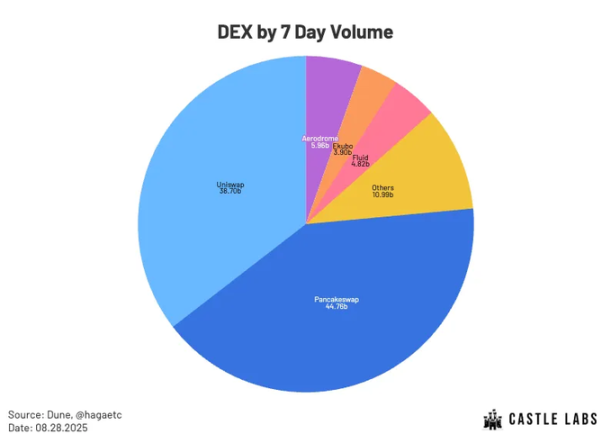
DEX Ranked by 7-Day Trading Volume, Source: Dune, @hagaetc
Moreover, the protocol is also expected to conduct a token buyback, as its annual revenue has exceeded $10 million. Fluid recently published related content on its governance forum; the post opened discussions about the buyback and proposed three methods.
View the different proposal methods here:
https://x.com/0xnoveleader/status/1957867003194053114
Upon governance approval (after discussion), the buyback will commence on October 1, with a 6-month evaluation period.
Jupiter Lend: Fluid's Entry into Solana
Fluid's expansion into Solana is accomplished in collaboration with @JupiterExchange.
Jupiter is the largest DEX aggregator on Solana, with a cumulative trading volume exceeding $97 billion, and is also a leading perpetual contract exchange and staking solution on Solana.
The TVL for lending on Solana currently exceeds $3.5 billion, with @KaminoFinance being a major contributor. The lending vertical on Solana presents significant growth potential for Fluid.
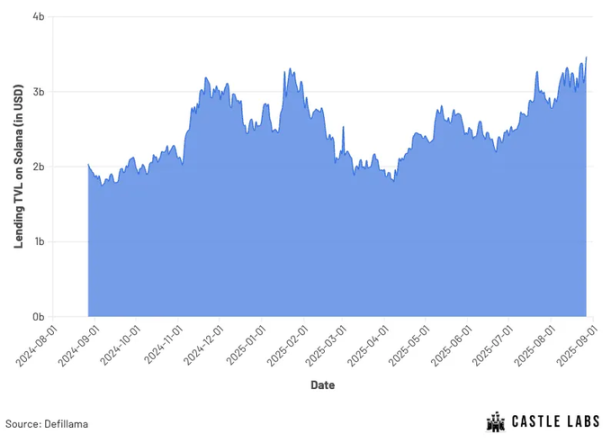
The public beta of @jup_lend recently launched after a few days of private testing. Its TVL has now surpassed $250 million, making it the second-largest money market on the Solana blockchain, second only to Kamino.

Jupiter Lend, launched in collaboration with Fluid, offers similar functionalities and efficiencies, with smart collateral and smart debt expected to launch on the platform later this year.
Additionally, 50% of the platform's revenue will be allocated to Fluid.
Iterations of Fluid DEX
Fluid has launched its DEX Lite and plans to roll out V2 soon. This section will cover both and explain how these iterations will help Fluid further develop.
Fluid DEX Lite
Fluid DEX Lite launched in August and serves as a credit layer on Fluid, enabling direct borrowing from the Fluid liquidity layer. It has begun providing trading volume services for relevant trading pairs, starting with the USDC-USDT pair.
This version of Fluid DEX is highly gas-efficient, reducing the cost of swaps by approximately 60% compared to other versions. It was created to capture a larger share of trading volume in relevant trading pairs, where Fluid is already the dominant protocol.
In its first week of launch, Fluid Lite generated over $40 million in trading volume, with initial liquidity borrowed from the liquidity layer amounting to $5 million.
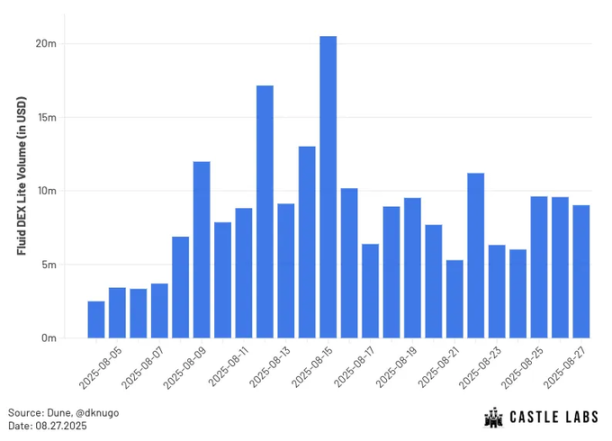
Fluid DEX Lite Trading Volume, Source: Dune, @dknugo
Fluid DEX V2
Fluid DEX V1 launched in October 2024, accumulating over $10 billion in trading volume on Ethereum in just 100 days, outpacing any decentralized exchange. To support this growth, Fluid is launching its V2 version, designed with modular and permissionless scalability in mind, allowing users to create multiple custom strategies.
First, V2 will introduce four different types of DEX within the protocol, two of which will carry over from V1. The types of DEX supported by Fluid will not be limited to these four, as more types can be deployed through governance.
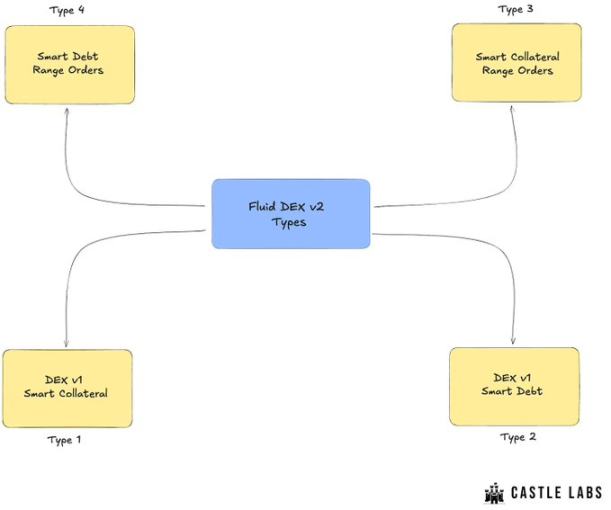
The two new types introduced are smart collateral range orders and smart debt range orders. Both allow borrowers to help improve their capital efficiency.
Smart collateral range orders function similarly to Uniswap V3, allowing users to provide liquidity by depositing collateral within a specific price range while also earning lending annual percentage rates (APR).
Smart debt range orders work similarly, allowing users to create range orders on the debt side by borrowing assets and earning trading annual percentage rates (APR).
Additionally, it introduces features such as hooks (similar to Uniswap V4) for custom logic and automation, flash accounting to enhance fee efficiency for CEX-DEX arbitrage, and on-chain yield accumulation limit orders, meaning limit orders can earn lending annual percentage rates (APR) while waiting to be filled.
Conclusion
Fluid continues to grow and improve by offering a range of unique features to become more capital efficient.
Smart Collateral: Collateral deposited on the platform can be used to earn lending interest and trading fees.
Smart Debt: Smart debt reduces the debt by using trading fees generated from the debt, making the borrowed debt productive for users.
Unified Liquidity Layer: Fluid's unified liquidity layer enhances the capital efficiency of the entire ecosystem through features such as higher LTVs, advanced liquidation mechanisms, and automatic caps for better risk management.
Its recent expansion into Solana through collaboration with Jupiter extends its market share in the lending category to non-EVM networks. Meanwhile, Fluid DEX Lite and DEX V2 aim to enhance the user experience on EVM chains and increase trading volume.
Furthermore, DEX V2 is expected to launch on Solana later this year, allowing Fluid to venture into the lending and exchange verticals on Solana.
免责声明:本文章仅代表作者个人观点,不代表本平台的立场和观点。本文章仅供信息分享,不构成对任何人的任何投资建议。用户与作者之间的任何争议,与本平台无关。如网页中刊载的文章或图片涉及侵权,请提供相关的权利证明和身份证明发送邮件到support@aicoin.com,本平台相关工作人员将会进行核查。




